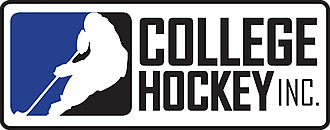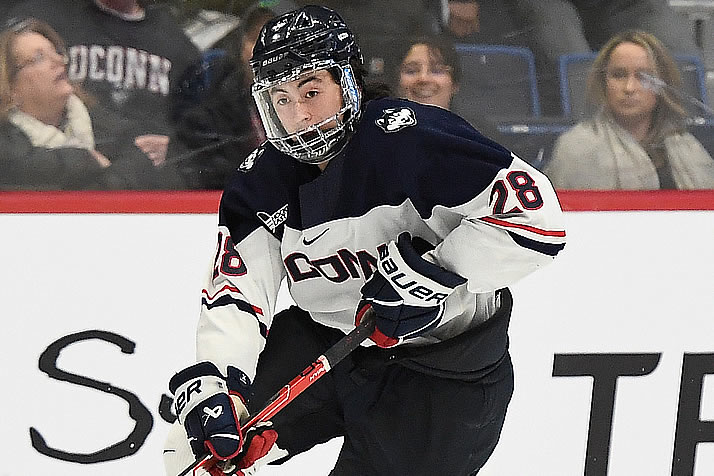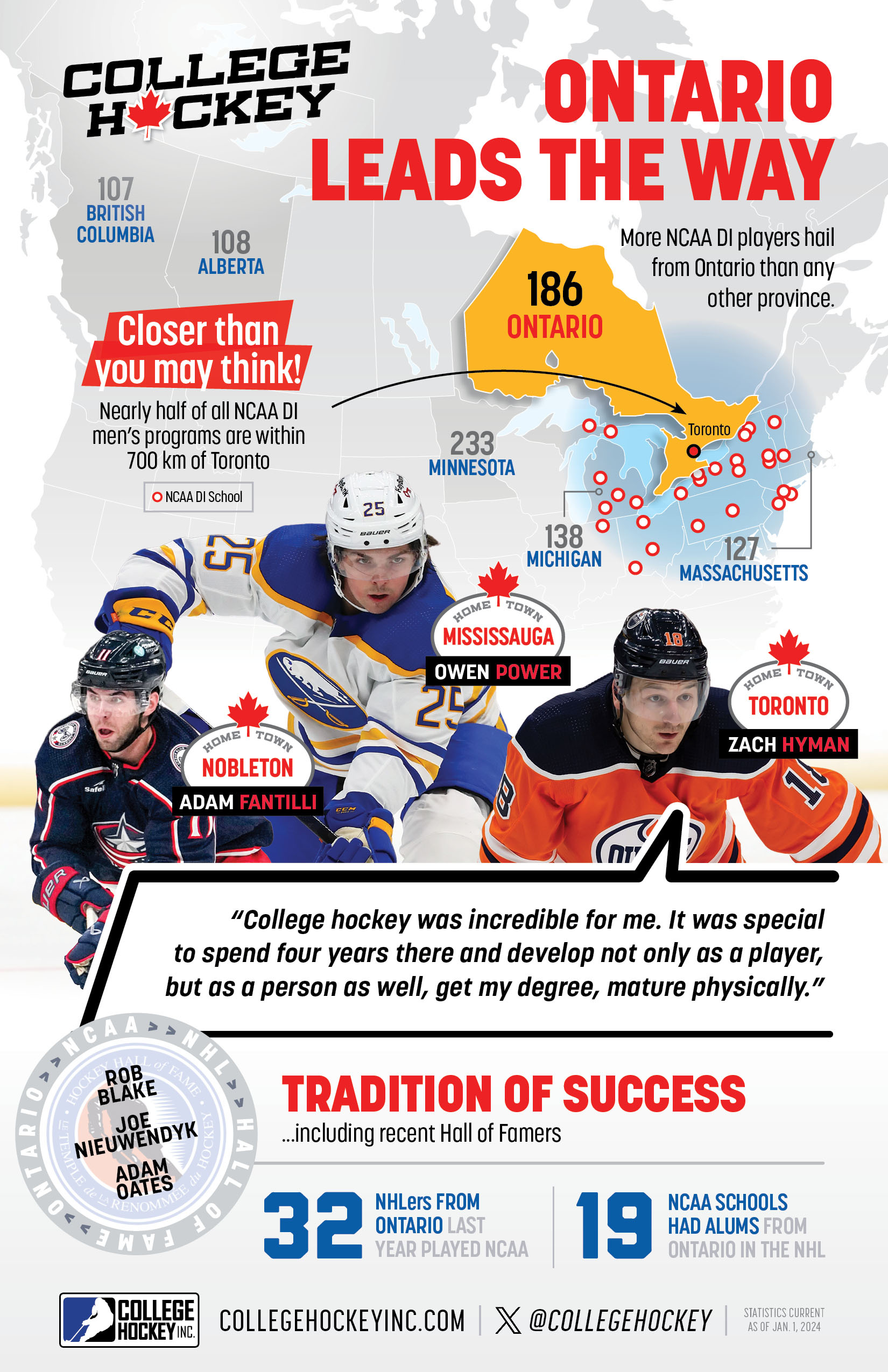


By Sean Hogan, Jayson Hajdu and Mike Snee
Note: This article was updated on January 2, 2024.
Ontario has long been a fruitful recruiting ground for NCAA Division I men’s hockey. In 2023-24 alone, more collegiate players hail from Ontario (186) than any other province and the sheer number of commitments signifies that trend will continue. That’s hardly surprising given its status as Canada’s most populous province, but Ontario isn’t just churning out quantity; it is also well-established for producing high-end NCAA hockey players.
Two of the nation’s top six scorers in NCAA Division I men’s hockey last season – Michigan’s Adam Fantilli (Nobleton) and Western Michigan’s Ryan McAllister (London) – came from Ontario, as do returning all-conference selections like RIT’s Gianfranco Cassaro (Nobleton), Michigan Tech’s Ryland Mosley (Arnprior), and Wisconsin’s David Silye (Nobleton).
The enormous impact Ontario natives are having on college hockey is nothing new. Hockey Hall of Famers Ken Dryden (Hamilton), Rob Blake (Simcoe), Tony Esposito (Sault Ste. Marie), Joe Nieuwendyk (Oshawa) and Adam Oates (Weston) all starred collegiately. Fellow Ontarians Tony Hrkac (Thunder Bay) and George McPhee (Guelph) won the Hobey Baker Memorial Award on their way to the National Hockey League.
How Does It Happen?
Is there a common path for Ontarians to best optimize NCAA opportunities? College Hockey Inc. studied the 186 players from Ontario who are on NCAA Division I men’s hockey rosters in 2023-24.
Noteworthy themes that emerged from the Ontario study:
Of the 186 commitments, 52 percent spent time in the OJHL and 18 percent spent time in the CCHL.
While not many players earned their commitment while playing in the GOJHL, 42 players who earned an NCAA Division I commitment did play in the GOJHL at one point.
The Data: Hockey Before NCAA
The average commitment age of players from Ontario was 19-years old. A vast majority of those players – 86 percent of them, to be precise – earned their commitments while playing in NCAA-eligible junior hockey in leagues such as the OJHL and CCHL.
As evidenced by the numbers below, Ontarians can be playing in a variety of leagues and locales and still have an opportunity to reach NCAA Division I. Of note, approximately 28 percent were not yet playing junior hockey at age 17.
| Where Ontarians played when they earned their commitments: | |
| League | No. |
| OJHL | 52 |
| BCHL | 34 |
| CCHL | 22 |
| AJHL | 19 |
| USHL | 17 |
| U16 AAA (CDN) | 9 |
| NAHL | 8 |
| CDN HS | 7 |
| USHS-PREP | 4 |
| GOJHL | 3 |
| 16U AAA (US) | 2 |
| U18 AAA (CDN) | 2 |
| MJHL | 2 |
| NCDC | 2 |
| U15 AAA (CDN) | 1 |
| SJHL | 1 |
| Where Ontario NCAA commitments were playing at 17: | |
| League | No. |
| OJHL | 62 |
| GOJHL | 26 |
| CDN HS | 23 |
| CCHL | 21 |
| U18 AAA (CDN) | 17 |
| USHL | 12 |
| USHS-PREP | 8 |
| 18U AAA (US) | 4 |
| NCDC | 3 |
| AJHL | 2 |
| NOJHL | 2 |
| BCHL | 1 |
| CCHL2 | 1 |
| Jr. C | 1 |
| MJAHL | 1 |
| NAHL | 1 |
Case Study I: Ryan Tverberg
University of Connecticut forward Ryan Tverberg, a native of Richmond Hill, was an NCAA Division I All-America selection as a sophomore in 2021-22 and earned All-Hockey East accolades as a junior last season.
Tverberg followed a linear path to college hockey, playing two seasons (2017-19) of AAA hockey in the Greater Toronto Hockey League (GTHL) with the Toronto Jr. Canadiens. After a late-season stint in the OJHL in 2018-19, Tverberg matriculated to that league for a full season in 2019-20 and emerged as a point-per-game player in the OJHL.
“I think building that relationship with the same teammates and coaches, especially on a good team, played a huge role in my decision to stay with one program,” said Tverberg. “Having stayed together for so long helped us build chemistry with one another and growing and learning together as a group factored into my decision.”
Following that 2019-20 season, Tverberg was selected by the Toronto Maple Leafs in the NHL Draft.
“I think these stops ultimately prepared me with a basic hockey sense at a young age and helped me gain a love for the game,” continued Tverberg. “Playing with both of those programs gave me confidence in my abilities and helped me build around my game to develop necessary skills to compete and play NCAA hockey.”
Following his junior year at UConn, signed an entry-level NHL contract with the Maple Leafs.
Case Study II: Adam Fantilli
Although not a typical or necessary path for NCAA-bound players from Ontario, Adam Fantilli played his U16 year at Kimball Union Academy, a historic prep school in the United States. U.S.-based prep schools have long played a vital role in the path to NCAA hockey for aspiring players in the northeastern United States (however, the schools are open to hockey players from everywhere).
Family considerations factored heavily into the decision for Fantilli, who was able to play with his older brother, Luca, at Kimball Union.
Following his time at Kimball Union, the Nobleton native played two seasons in the USHL – again reuniting with his brother – where he won a Clark Cup title as a rookie and captured All-USHL First Team honors his second year.
Fantilli then made a massive, immediate impact as a freshman at the University of Michigan, winning the 2022-23 Hobey Baker Award as the best player in NCAA Division I men’s hockey.
“I think once I got older and matured a little bit, I saw the benefits to going to college. I thought that was the right route for me,” Fantilli told The Michigan Daily.
Following a season that also saw him lead the Wolverines to the NCAA Frozen Four, Fantilli was drafted third overall by Columbus at the 2023 NHL Entry Draft and is currently enjoying his NHL rookie season with the Blue Jackets.
There has been a common conclusion throughout College Hockey Inc.’s previous “paths” studies: that a player does not need to leave home to be on the radar of NCAA Division I recruiters but rather, playing and playing well are most important.
This certainly holds true for the province of Ontario, as evidenced by the sheer number of Ontarians committing to and playing for NCAA Division I schools. Leagues within the province, such as the OJHL, CCHL and other college-eligible junior hockey leagues, play a vital role in player development for future NCAA Division I players.
For young aspiring hockey players in Ontario, the optimal path to NCAA Division I hockey is the one that begins right in their own backyards.
NOTE: Click HERE to view each of College Hockey Inc’s “paths” studies.
